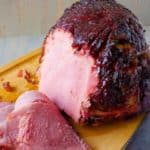Recipeclock clock iconcutlery cutlery iconflag flag iconfolder folder iconinstagram instagram iconpinterest pinterest iconfacebook facebook iconprint print iconsquares squares iconheart heart iconheart solid heart solid icon

Create a glaze for the ham. In a saucepan, combine the ground black pepper, orange juice, chili sauce, vinegar, brown sugar, Dijon mustard, and soy sauce. Over medium-high heat, cook the glaze until only 1 cup is left.
Check the temperature of the ham. The ham can be safely removed from the grill once it reaches an internal temperature of 135 degrees.
Close the lid to the grill. As the whole ham cooks, keep an eye on the temperature and make sure to keep it between 300 and 350 degrees. To regulate the temperature, open or close the grill’s vents or change the heat setting using the grill’s knobs.
For an additional hour to a half, bake the whole ham on the gas grill. For every pound of ham, the cooking time is approximately 10 minutes. Every half-hour, add glaze to the ham to continue flavoring it.
If the pan is dry, add more water to the ham. As it dries, you can keep adding water in 1-cup increments.
Everyone adores the glazed, sugar-coated hams that you line up for during the holidays. With a good grill, it’s actually very simple to prepare these hams on your own. The key is getting the sugar to melt and caramelize on the ham’s surface. The benefit is that you can simultaneously heat the ham and coat it, making it taste as though it just came off the grill. The best way to cook ham is on a rotisserie so that you can expose the entire surface to the heat necessary to develop that crust.
The sugar you use on your ham is actually important. Because it is so fine, regular sugar doesn’t produce the best surface. Use a coarse sugar like raw sugar or turbinado sugar. These are the best. You can quickly and easily access the entire ham if you leave the rotisserie running while you do the basting and sprinkling.
Keep in mind that hams are fully cooked or cured and do not require cooking to be consumed. Simply heating it will bring it to a suitable temperature for your meal. You want to heat it over a low to medium flame, similar to how you would a ham in the oven. The ham must become warm throughout without the surface becoming overly dry or cooked. Like you would in the oven, allow 13 minutes per pound. You can begin sprinkling the sugar to make the crust once the ham has heated internally to about 150 F (65 C). Make sure to take temperature readings at least twice. Since bone heats up more quickly than meat, you don’t want the area to be too cold and you want to keep the thermometer away from the bone.
Now it is time to caramelize the sugar. Keep in mind that sugar begins to burn at 265 F (130 C), so you must closely monitor both the ham and the sugar. The sugar should be just right and the ham should be ready to be removed from the grill in about 20 minutes if you simply close the lid and turn the heat to low. Turn up the heat on your grill’s rotisserie burner if you have one to quickly caramelize the sugar, say for five minutes. In either case, you must pay close attention to the procedure. Once sugar starts to burn you are in trouble. You cant “un-burn” sugar and the flavor is not good. You will end up cutting the surface off the ham.
You need to turn off the heat and wait for the mixture to cool down sufficiently for the sugar to harden, assuming everything went according to plan and the sugar has melted and caramelized, giving your ham a great crusty surface. Leave the rotisserie going and open the lid. Before attempting to remove the ham from the grill, give it about 10 minutes or until the surface has cooled and the sugar has hardened. Once off, carve and serve.
